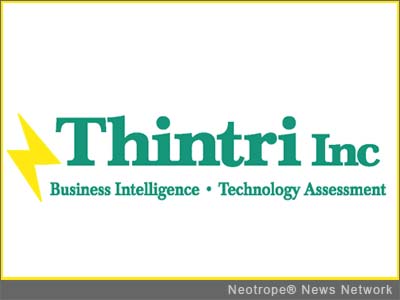 NEW YORK, N.Y. /eNewsChannels/ — NEWS: A new report from Thintri, Inc., says wireless technologies are poised to radically transform healthcare as we know it today. The emergence of these technologies coincides with a rapidly evolving regulatory environment, an overhauled insurance regime and new business models such as fee-for-outcome replacing fee-for-service and growing interest in using wireless technology in patient care, fitness and wellness, facilities management and other applications.
NEW YORK, N.Y. /eNewsChannels/ — NEWS: A new report from Thintri, Inc., says wireless technologies are poised to radically transform healthcare as we know it today. The emergence of these technologies coincides with a rapidly evolving regulatory environment, an overhauled insurance regime and new business models such as fee-for-outcome replacing fee-for-service and growing interest in using wireless technology in patient care, fitness and wellness, facilities management and other applications.
Biomedical Wireless Technology, Networks and Sensing Systems, or BiowireleSS, is rapidly becoming an integral component of healthcare delivery. A number of wireless technologies are being brought to bear on a long list of healthcare and pharmaceutical applications with the promise of utterly transforming healthcare over the present decade.
BiowireleSS will bring unprecedented efficiencies and productivity to pharmaceutical production and healthcare delivery while lowering costs, enhancing safety and improving patient outcomes. More importantly, many patients and their healthcare providers will experience far more freedom and flexibility. Rather than being confined to a hospital, soon many patients will be monitored at home, free to go about their normal activities, while a wireless device transmits data to healthcare providers, who will be alerted if vital signs deviate from normal ranges. Hospitals will use wireless technology to instantly track equipment and staff, and automate facilities management and record-keeping, with far greater efficiency and reliability than was previously possible. Consumers will find a host of new devices available to track and monitor their own fitness and wellness regimes.
Wireless technologies applicable to healthcare will include wireless personal area networks (WPANs) and sensors that directly monitor vital signs while transmitting data through a user’s smartphone or laptop to a healthcare provider’s office. These devices will be incorporated into smart garments and e-textiles; wearable sensors that can be worn on the wrist, in armbands, etc.; other sensors that are attached directly to the skin, and even epidermal electronics, small, temporary tattoo-like patches that will monitor a host of body functions. RFID/RTLS systems will allow instant tracking and locating of both hospital staff and equipment, as well as tracking of pharmaceuticals throughout the supply chain to prevent counterfeiting. Wireless imaging and video will facilitate remote diagnosis for those lacking access to specialists. Smartphone apps will bring healthcare information directly to consumers. Many other scenarios are emerging as well.
The development of these wireless technologies, many already commercialized or near market entry, comes as a “perfect storm” takes place, largely due to recent Federal legislation that can only be implemented in any practical sense by use of such technologies. The Patient Protection and Affordable Care Act, also known as the ACA or “Obamacare,” will implement extraordinary measures to increase the efficiency and reliability of the US healthcare system, fundamentally changing the way physicians and hospitals keep records and interact with patients, and clearing the way for remote monitoring of patients.
Other ACA provisions, while not explicitly concerned with technology, will force healthcare providers to find new ways to increase efficiency and effectiveness, and thus maximize health and wellness, as part of a broad move from fee-for-service to fee-for-outcome. Many of the requirements of the ACA are in line with the capabilities of emerging wireless technologies and will be both a major market driver for the technologies while at the same time being virtually impossible to meet, in any practical sense, without them.
However, the road to implementation of BiowireleSS will not be smooth. Many technologies that could open up new wireless healthcare markets are still too costly. Customer education remains a significant obstacle as well.
Thintri’s report, BiowireleSS: Opportunities in Wireless Healthcare, projects a burgeoning but complex market in wireless healthcare delivery over the course of the present decade, with totally new markets created while others are left behind. More details can be found at http://www.thintri.com/biowireless-report.htm .
About Thintri, Inc.:
Founded in 1996, Thintri, Inc. (www.thintri.com), is a full-service consulting firm, based in New York and directed by J. Scott Moore, Ph.D.
Thintri’s services include business intelligence, market research, technology transfer and technology assessment, and in-depth, off-the-shelf market studies on promising emerging technologies. Topics of focus have included communications, aerospace, medical and industrial imaging, photonics, materials and coatings, semiconductor devices, manufacturing, industrial logistics, security, thermal management, energy, and a host of others.
For more information, visit http://www.thintri.com/ or call 914-242-4615.
This version of news story is Copr. © 2014 eNewsChannels™ (www.enewschannels.com) and the Neotrope® News Network – all commercial and reprint rights reserved. Unauthorized reproduction in whole or in part without express permission is prohibited.



